Introduction to IoT
Transforming into a revolutionary technological paradigm, the Internet of Things (IoT) concept has fundamentally reshaped our interactions with the surrounding world. The seamless integration and interconnection of physical and digital entities are implied by the Internet of Things (IoT), achieved through the utilization of computing, advanced sensing, and communication technologies.
Definition
Defined as the network of physical objects or "things" equipped with sensors, software, and various technologies, the Internet of Things (IoT) interconnects through the Internet or other communication networks. This connectivity empowers these objects to gather, exchange, and act on data, frequently without requiring human intervention.
Architecture
Typically, the IoT architecture is classified into the following layers:
Perception Layer: To gather data and perform actions, perception layer comprises of sensors and actuators that interface with the environment.
Network Layer: The network layer uses communication protocols to facilitate the transmission of data from the perception layer to other layers.
Middleware Layer: The middleware layer acts as a bridge between the hardware and application layers to give important services such as data processing, storage, and management.
Application Layer: Comprising end-user applications, the application layer provides customized services and solutions by utilizing data received and processed from the lower layers.
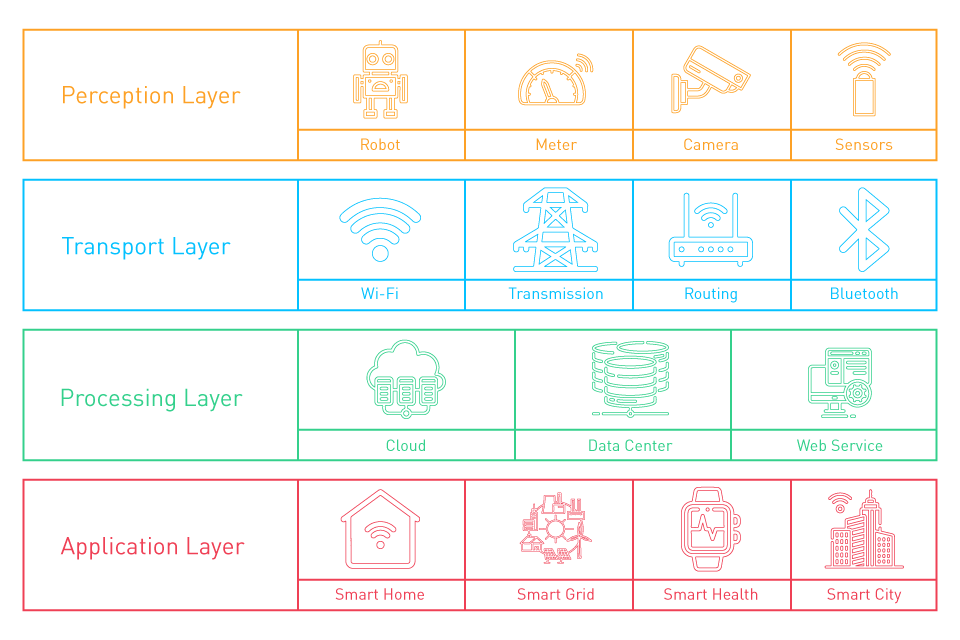
Figure 1: IoT Layers
Key Components
Sensors: Playing a crucial role in perceiving the physical world, sensors serve as essential components responsible for monitoring and collecting data from the environment.
Actuators: Based on the processed data or received commands, actuators perform actions in the physical world.
Gateways: Functioning as intermediaries connecting sensors/actuators to the network, gateways carry out initial data processing and protocol translation.
Communication Networks: Enabling data transmission among components, these are essentially important for IoT and commonly utilize wireless communication technologies.
Data Processing and Storage: Data processing and storage is usually incorporated through cloud services or edge computing solutions and essential for handling the larger volumes of data.
Applications: The end-user experience involves transforming processed data into meaningful insights and actionable information.
Transforming the technological landscape, the Internet of Things (IoT) merges the physical and digital realms through intelligent, interconnected devices. Incorporating distinctive functionalities, a multilayered architecture defines the Internet of Things (IoT), comprising perception, network, middleware, and application layers. Realizing the extensive potential of IoT requires the essential synergy of sensors, actuators, gateways, communication networks, data processing, and applications. This collaboration is crucial for creating smart, autonomous, and user-centric solutions across diverse domains, reshaping our interaction with the world and enhancing our capabilities in unprecedented ways.
Role of Angular Position and Current Sensors in IoT
Within the vast ecosystem of IoT, fundamental elements are angular position sensors (utilized for measuring rotary displacement) and current sensors. These components extend their functionalities well beyond mere data acquisition. Their paramount significance extends into various applications, including robotic control and grid management, playing a central role in advancing industries and realizing smart environments.
Importance in Robotic Control
In robotic control, angular position sensors play an imperative role that contributes to the accuracy and dependability of robotic movements and functions. They facilitate fine control over the positioning and orientation of tools by precisely measuring the angular displacement of robotic joints and elements. Particularly crucial in applications such as surgical robots, the smallest inaccuracies can have serious consequences. In addition, electric current flowing through motors is monitored by current sensors. This monitoring aids in detecting anomalies and ensures optimal energy consumption, thereby maintaining the efficacy and life of robotic systems.
Grid Management
Within the realm of electric grid management, monitoring the flow of electric current across the grid is inseparable, with current sensors playing a crucial role. Offering real-time data on current flow, they facilitate the swift detection of overloads or faults in the system. To avert extensive damage and ensure the stable function of power grid, this prompt detection is important. In this domain, angular position sensors play a vital role in precise control of circuit breakers and switches; thus, leading to the effective and safe operation of the power distribution network.
Extended Applications
The combined use of angular position and current sensors extends beyond robotic control and grid management, finding applications in various fields. Integral to the operation of electric vehicles, they play a crucial role in monitoring motor performance and managing power distribution. Angular position sensors are utilized in renewable energy systems, such as wind turbines, to optimize blade angles for maximizing energy capture. Concurrently, current sensors monitor the generated power output.
Enhanced Operational Intelligence
Enriching operational intelligence, the inclusion of these sensors in IoT environments facilitates real-time monitoring, enhanced automation, and predictive maintenance. Empowering systems to learn, adapt, and optimize performance is achieved through the seamless integration of angular position and current sensors with advanced data analytics and machine learning models. This integration builds innovative solutions and enhances efficiencies across numerous fields.
Integral components of the IoT landscape, angular position and current sensors play critical roles in applications such as robotic control and grid management, ensuring accuracy and reliability. Extending their contribution to various domains, from industrial setups to renewable energy systems, angular position and current sensors optimize operational intelligence, enhance automation, and enable predictive maintenance. This solidifies their role in the progressing field of interconnected technologies.
Sensor Gateways and Edge Computing
The complex network of IoT is combined with data threads, and it is crucial to efficiently manage this abundance of information. Playing a pivotal role in this context, Sensor Gateways and Edge Computing provide a framework to manage data at the source, thereby mitigating latency.
Data Pre-Processing at the Source
Serving as the bridge between sensor devices and the cloud, Sensor Gateways undertake essential functions like collecting, filtering, and processing the data. Reducing the volume of data requiring transmission to the cloud, Sensor Gateways play a critical role through preprocessing at the data source. In applications demanding real-time data analysis, like autonomous vehicles and industrial automation systems, the importance of localized processing is pivotal. Delays in data processing can result in functional inefficiencies or, in extreme cases, catastrophic failures.
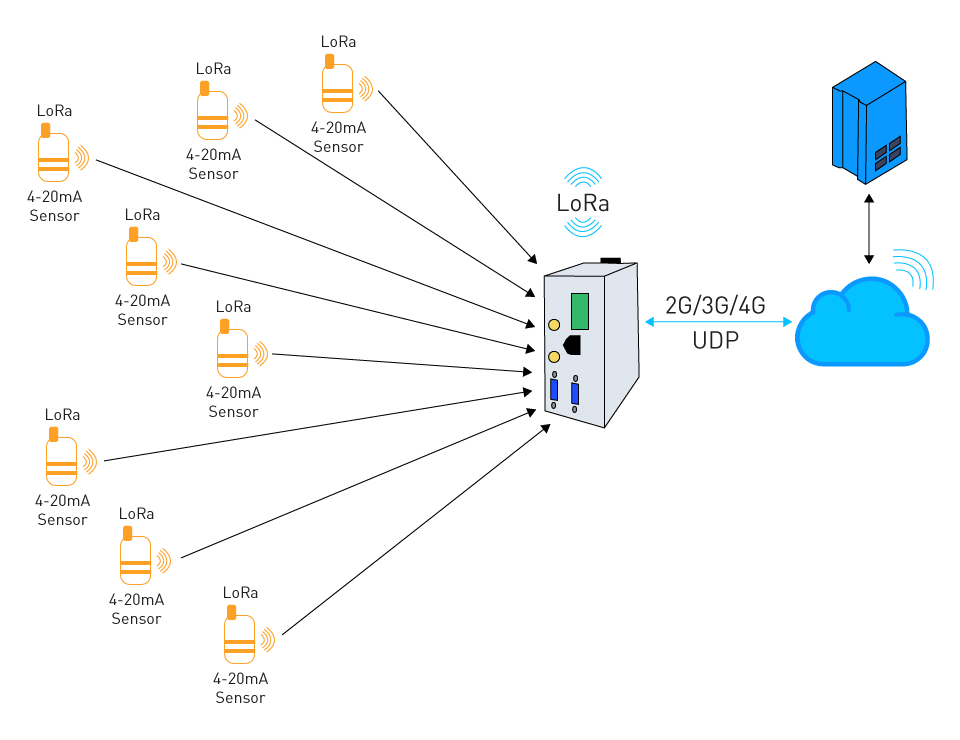
Figure 2: LoRa WSN with Gateway
Reducing Latency with Edge Computing
Advancing the concept of data preprocessing, edge computing takes a step further by positioning computing resources closer to the source of data. Processing data at the network's edge, as opposed to a centralized data center, leads to a significant reduction in latency and enables faster data processing and analysis. Critical in applications demanding split-second decisions, like emergency response systems or real-time monitoring of critical infrastructure, this aspect becomes paramount.
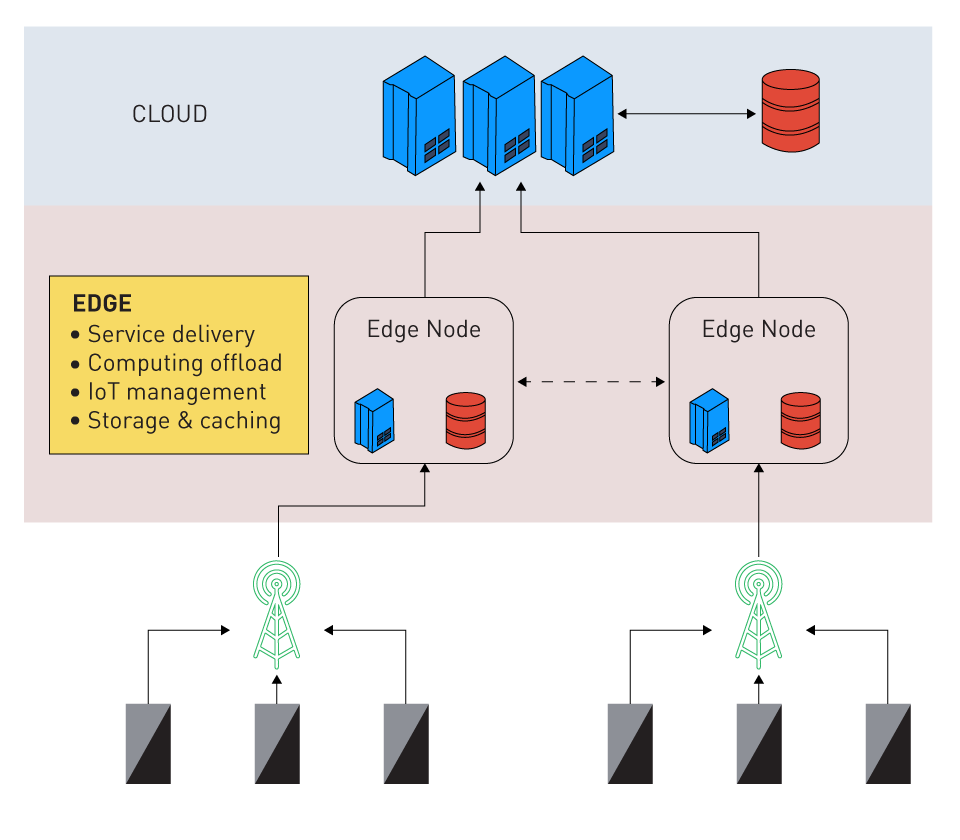
Figure 3: Edge Computing
Augmented System Efficiency
Through the utilization of Sensor Gateways and Edge Computing, systems can transmit only the most relevant and processed data selectively, thereby lessening the network load and conserving bandwidth. Enhanced efficiency and speed are not the only outcomes; there is also a translation to reduced operational costs. This is achieved through the requirement for less data transmission and storage, allowing potential issues to be promptly identified and addressed.
Enhanced Security and Privacy
Implications for security and privacy are also introduced by processing data at the source. Mitigating the risk of data breaches and leaks is achieved by decreasing the transmission of raw, potentially sensitive data across the network. Furthermore, localized data storage facilitated by edge computing enables improved compliance with regulations related to data residency and sovereignty.
IoT ecosystem consists of Sensor Gateways and Edge Computing that offers a solution for effective data management and decreasing latency by preprocessing data at the source. Crucial in applications necessitating real-time data analysis and swift decision-making processes, they contribute to enhanced operational efficiency, improved security and privacy, and optimal resource utilization. This makes way for the development of more modern and responsive IoT systems.
Smart Grids, Smart Machines, and Industrial IoT
Various domains such as manufacturing machines, energy grids, and the broader scope of industrial processes are greatly impacted by the evolution of the Internet of Things (IoT). Unprecedented enhancements in predictive maintenance, real-time analytics, and factory automation are being experienced in Smart Grids, Smart Machines, and Industrial IoT through the implementation of IoT.
Predictive Maintenance
To monitor equipment conditions and performance in real-time, multiple sensors are used for prediction maintenance, which is a pivotal application within industrial IoT. Predicting potential equipment failures before they occur is possible through the utilization of advanced data analytics and machine learning algorithms. This allows for timely interventions. Anticipating maintenance needs in advance reduces unplanned downtime, extends equipment lifespan, and optimizes operational efficiency. This ensures uninterrupted production flows and results in substantial cost savings in industrial settings.
Real-Time Analytics
Critical in optimizing industrial operations, real-time analytics processes and analyzes data instantaneously as it is generated. Within the framework of smart grids, real-time analytics aids in the monitoring and management of energy consumption, distribution, and quality. It enables the instantaneous detection and rectification of anomalies. In the realm of smart machines, continuous insights into performance metrics are provided by real-time analytics. This allows for instantaneous adjustments to functional parameters, ensuring optimal performance and decreasing waste and inefficiencies.
Factory Automation
Empowered by IoT technologies, factory automation has undergone a revolution in manufacturing processes, integrating advanced robotics and intelligent control systems. Enabling the automation of repetitive and complex tasks, this integration results in heightened productivity, superior product quality, and enhanced operational safety. Through collaboration, smart machines equipped with diverse sensors can adaptively optimize their functions by considering environmental and operational conditions. This contributes to the overall efficiency and flexibility of manufacturing processes.
Industrial IoT Integration
Within industrial environments, a cohesive and intelligent ecosystem is formed by the integration of these advanced technologies through Industrial IoT. Transitioning from reactive to proactive operational models, industries are empowered by this integration to leverage data-driven insights for optimizing every facet of their operations. Within this ecosystem, the convergence of smart grids and smart machines ensures seamless interaction and cooperation among diverse industrial components. This convergence propels innovation and progress in industrial domains.
Impact and Significance
A paradigm shift in industrial operations, facilitating sustainability, innovation, and efficiency are marked by the combination of smart grids, industrial IoT, and smart machines. Optimizing resource utilization, enhancing operational reliability, and mitigating risks is achieved by industries through harnessing the power of predictive maintenance and real-time analytics. This paves the way for a more resilient and sustainable industrial future.
Redefining the paradigms of industrial operations, the integration of IoT technologies in smart grids, smart machines, and the broader industrial sector is underway. Through the utilization of predictive maintenance, real-time analytics, and factory automation, Industrial IoT facilitates enhanced operational efficiency, resource optimization, and innovative advancements. This steers industrial domains toward a future characterized by sustainability, resilience, and unprecedented progress.
IoT Protocols and Data Management
The structuring and management of data are inseparable to functional optimality in the architectural fabric of IoT. Utilizing protocols specifically designed for the constraints of IoT devices and organizing data in structures such as data lakes are integral aspects of this process. Presented below is an exploration of IoT protocols such as MQTT and CoAP, along with concepts related to cloud integration and data lakes.
Message Queuing Telemetry Transport (MQTT)
Designed for low-bandwidth, high-latency, or unreliable networks, MQTT is a lightweight messaging protocol, making it particularly well-suited for IoT applications. Utilizing a publish/subscribe model, MQTT reduces network bandwidth requirements and minimizes device resource demands. Essential for maintaining the synchrony of data states across IoT ecosystems, the design of MQTT allows for real-time updates. In home automation systems and wearable healthcare devices where timely delivery and minimal footprint are paramount, it is particularly useful.
Constrained Application Protocol (CoAP)
Expressly designed for constrained devices and lossy networks in IoT applications, CoAP is another protocol. Employing a request/response model, it supports the discoverability of services and resources. While MQTT differs from CoAP, the latter is more akin to HTTP, simplifying integration with web services. Despite this similarity, CoAP retains a low overhead and supports multicast, which is crucial for scalability in IoT environments.
Cloud Integration
A foundational pillar in IoT data management, cloud integration delivers scalable storage solutions and advanced computational resources for the analysis of collected data. Facilitating real-time processing and analytics of data generated by IoT, the cloud promotes actionable insights and enhances decision-making processes. Leveraging the virtually unlimited computational power and storage capacity of the cloud is crucial for IoT devices, thanks to this amalgamation. It becomes particularly important in handling the heavy data loads generated in IoT environments.
Data Lakes
Within the realm of IoT, data lakes function as centralized repositories capable of storing data, whether structured or unstructured, at any scale. Preserving raw data and enabling comprehensive analytics, they accommodate the diverse and massive influx of IoT data. Supporting the derivation of meaningful patterns and insights from agglomerated data, data lakes contribute to enhancing the functionality, efficiency, and intelligence of IoT systems.
Challenges and Significance
Advanced techniques are required to navigate through the intricate web of IoT protocols and manage the deluge of generated data. Optimally aligning with the requirements of the IoT application necessitates careful consideration of chosen protocols. This balance is crucial, accounting for resource constraints and meeting performance expectations. Simultaneously, pivotal to extracting the inherent value in accumulated data is efficient data management, encompassing cloud integration and data lakes. This unlocks the full potential of IoT systems.
Any IoT system consists of effective IoT Protocols and robust data management, that ensures secure and efficient data handling, seamless communication, and the extraction of meaningful insights from the data. Tailored to meet the unique needs of IoT devices, protocols like MQTT and CoAP, along with cloud integration and data lakes, play integral roles. They facilitate scalable storage, advanced analytics, and the seamless integration of IoT devices within broader ecosystems. This propels IoT systems to new heights in operational intelligence and efficiency.
IoT Security and Ethical Implications
Significant challenges in handling security and addressing ethical concerns have been invoked by the rise in the implementation of IoT devices. Given their interconnected and integrated nature, IoT systems are susceptible to a range of security threats. The substantial amount of data they collect, and process underscores the need for meticulous ethical standards.
Security Challenges in IoT
Multifaceted security vulnerabilities, such as unauthorized access, data breaches, and denial of service attacks, are introduced by the inherent diversity and ubiquity of IoT devices. Implementing robust security mechanisms is particularly challenging due to the resource-constrained nature of many IoT devices. Amplifying the potential impact of security breaches, the extensive interconnectivity between devices allows compromised ones to be exploited for attacking other nodes in the network.
A holistic approach to security in IoT is imperative. This approach should not only focus on safeguarding individual devices but also ensure the security of data during transmission and storage. Additionally, it involves enhancing the resilience of the entire network against attacks and applying measures such as regular software updates and patches to address susceptibilities.
Ethical Data Collection and Use
Pressing ethical concerns arise from the vast quantities of data collected by IoT devices, particularly in relation to user privacy and data usage. Adherence to ethical standards, respecting user autonomy, confidentiality, and informed consent, is paramount in the collection and processing of data. Serious repercussions, such as breaches of privacy and loss of user trust, may result from inappropriate data collection or unauthorized use and sharing of sensitive information.
The ethical implications also encompass the consequences of data-driven decisions made by IoT systems. To prevent biases and ensure equitable outcomes, scrutiny of the algorithms processing IoT data is essential, focusing on transparency, fairness, and accountability. To effectively address these ethical considerations, it is essential to develop and adhere to comprehensive ethical guidelines and frameworks.
Strategies for Addressing Security and Ethical Challenges
Essential for mitigating security risks is a multi-layered security strategy that includes device-level security, secure communication protocols, and secure data storage and processing. The security posture of IoT systems can be fortified by using authentication, encryption, intrusion detection, and response mechanisms.
In addressing ethical considerations, it is imperative to establish and communicate clear, and transparent policies outlining data collection, processing, and sharing practices to users. Strict adherence to data protection regulations is essential. Crucial for fostering trust and responsibility in IoT deployments is the continuous undertaking of ethical assessments and reviews of IoT practices and policies. This approach helps identify and address potential ethical dilemmas.
In the design and deployment of IoT systems, IoT security and ethical implications are imperative elements that need meticulous attention. Robust and comprehensive strategies are imperative to address the intertwined challenges of maintaining security in diverse, interconnected environments and ensuring ethical data collection and usage. Reinforcing the integrity, reliability, and societal acceptance of IoT technologies can be achieved by implementing stringent security measures and upholding ethical standards. This paves the way for responsible and sustainable advancements in the field of IoT.

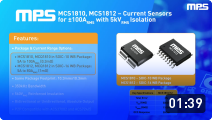
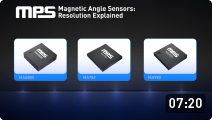





直接登录
创建新帐号